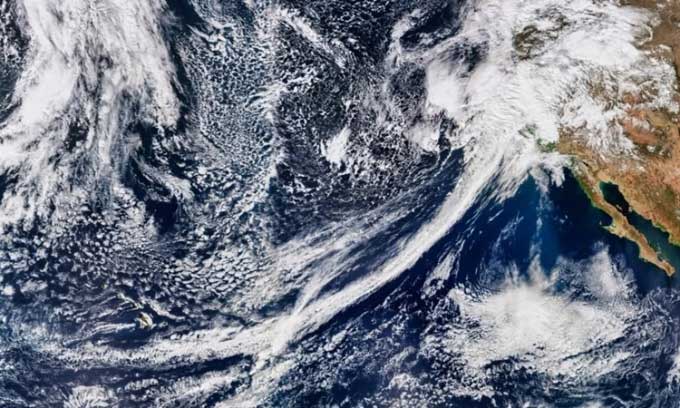Where many atmospheric rivers on Earth are concentrated
Rivers of water vapor stretching more than 1,600km across the sky have been moving from temperate regions to closer to the poles over the past 40 years .
Although atmospheric rivers have played an integral role in the water cycle since long before the dinosaurs, the term was first described as recently as 1994. They are long, narrow columns of water vapor that flow through Earth's atmosphere , like rivers in the sky. Atmospheric rivers transport water from the tropics near the Earth's equator to temperate zones and beyond. They are a temporary phenomenon, and an average of four to five atmospheric rivers exist at any given time , according to the US Department of Energy (DoE).

According to NASA, atmospheric rivers carry twice as much water as the Amazon River. (Photo: IFL Science).
Perhaps the most famous of these atmospheric rivers is the Pineapple Express , which starts in the Pacific Ocean near Hawaii and hits the west coast of the United States. As NASA explains, atmospheric rivers tend to occur in the extratropical regions of the North and Southeast Pacific, as well as North and South America. Atmospheric rivers can travel huge distances , typically landing in temperate regions between 30 and 60 degrees north and south latitude, such as the west coasts of the Americas, Europe, Southeast Asia, and New Zealand. There, they release their water as rain or snow.
Atmospheric rivers are integral to the world's water systems and provide a major source of water. In fact, according to the National Oceanic and Atmospheric Administration (NOAA), about 30 to 50 percent of the annual rainfall on the West Coast of the United States is the result of some form of atmospheric river event. Meanwhile, countries like France, Spain, the United Kingdom, and regions like Southeast Asia receive more than half of their rainfall from atmospheric rivers.
But they also have the potential to trigger severe flooding, landslides, and property damage. That was the case in North America earlier this year. In September, a particularly strong atmospheric river dumped heavy rain for several days across Canada and southeastern Alaska.
While temperate regions have historically received more rainfall from atmospheric rivers, scientists have recently discovered that small changes due to climate change could have a big impact on the world's water supply. Research by a team of experts at the University of California, Santa Barbara, has revealed a shift in the location of atmospheric rivers. The findings suggest that they have moved an average of 6 to 10 degrees closer to the poles over the past 40 years. This change could lead to severe drought in subtropical regions such as Brazil and wetter conditions in countries near the poles in Europe and the Pacific Northwest of the United States.
The researchers also point out that this change could exacerbate a trend toward greater sea ice loss in the Arctic. As atmospheric river precipitation becomes more common in the polar regions in winter, these regions have less time to recover from summer snowmelt.
- 'River in the sky' can cause floods to destroy species
- Video: The atmospheric river causes 43 days of continuous rain in the United States
- Where 99% of the gold on Earth is concentrated
- This is the real reason why rivers never flow in a straight line
- Rivers are infected with antibiotics
- Concentration of CO2 in the Earth's atmosphere hits 415ppm: highest since humanity appeared
- The atmosphere gradually disappears, the Earth will be as dry as Mars
- Shock discovery: Half of global rivers 'evaporate' 24 hours a year, what catastrophe does this imply?
- Top 6 dry rivers on Earth seen from space
- Phu Yen: Heavenly ducks appear black on the Ba River
- In the north, there is a widespread rain, and floods appear on the rivers
- The process of concentrated acid destroys the human body
 'Fine laughs' - Scary and painful torture in ancient times
'Fine laughs' - Scary and painful torture in ancient times The sequence of numbers 142857 of the Egyptian pyramids is known as the strangest number in the world - Why?
The sequence of numbers 142857 of the Egyptian pyramids is known as the strangest number in the world - Why? History of the iron
History of the iron What is alum?
What is alum?